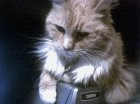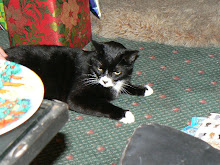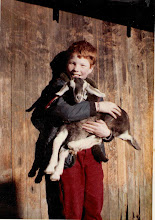Tuesday, January 29, 2008
Tools a Librarian (or a Teacher) Could Love...
As many of you reading this will know, WorldCat is a comprehensive database allowing you to search for and find items in libraries all over the world. Here in the world of libraries, we already use WorldCat to find items that KRL doesn’t have. Now it seems like we could link this application to our library page in Facebook, making our site that much more vibrant for all those students and researchers out there in search of books. In case you’re worrying that it’ll send them to other libraries for books we have: not so much. It shows a list of owning libraries by proximity, starting with the closest library.
Easy Bibliography Generator is just what it sounds like. You plug in source information, and Easy Bibliographer Generator creates a properly formatted citation in any of a variety of citation styles, including MLA, Chicago Manual of Style, and even the dreaded and deeply stress-inducing APA style. (Yes, people, I teach a class at UOP that includes an intensive component on APA formatting, and it is evil. APA, I mean, not my class. Maybe the class, too. You’d have to ask my students.) Using this site, you can properly format bibliography entries for books, journals, Web sites, lectures, interviews, and more. For those of you referring patrons or students to style manuals, this is an outstanding tool to add to your repertoire.
Friday, January 25, 2008
Here Be Dragons, or Be Careful What You Drink
There is an old Norse legend, perhaps best known through Wagner’s opera Siegfried, that he who drinks the blood of dragons will be gifted with the ability to understand the language of birds. In that legend, Sigurd (or Siegfried) slays the dragon Fafnir and then either bathes in and takes a celebratory chug-a-lug of his enemy’s blood or just accidently gets some blood in his mouth, depending on what folkloric version you favor. Either way, Sigurd doesn’t learn any pithy lessons about being careful what you put in your mouth, because he mostly gets a lot of helpful oracular advice from his feathered friends.
That said and Niebelung legends aside, perhaps my favorite representation of the dragon’s blood legend appears in Newbery Honor author Nancy Farmer’s wonderful blend of historical fiction and myth-inspired adventure, The Sea of Trolls, in which young Saxon Jack and his Viking captors encounter dragons, trolls, giant spiders, and more, when they embark on a series of adventures rooted in Norse legend. In Farmer’s representation, Viking berserker-initiate Jill becomes infected with dragon’s blood and discovers it’s a bit more of a mixed blessing than the story of Sigurd suggests. She learns that while the avian population might chirp up some good gossip, such as whether your enemies are massing over the next hill, mostly they just do a lot of what my dad used to call nattering and gromishing. That is to say, they talk a lot about very little.
So where am I headed with this? Well, Farmer’s musings on dragon’s blood and the language of birds provide as good a metaphor as any for the infamous social networking and micro-blogging service Twitter, currently under exploration for its value in the world of libraries.
While I see a certain potential value in Twitter as an up-to-the minute communication tool for far-flung and “virtual” work teams (virtual, that is, in the sense of teams working together in an online or virtual environment such as email, blogging, or twittering), Twitter can also represent a time and productivity drain for workplaces and a hotbed for missing and missed communications if not used properly or if too heavily or inappropriately relied upon as a communication tool. Still, keeping that concern in mind, there can be some big pluses for team Twittering. Just by way of example, while I was logged onto Twitter for krl2pt0 purposes I observed KRL Training Coordinator Bob Christensen’s of-the-moment update that he had posted new materials on the krl2pt0 site. Hmmm. Imagine if I were working on a time-sensitive project and looking for input from teammates. The entire work team could be instantly directed to Bob’s input and ideas even as he produced them. So… In a nutshell, Twitter strikes me as best designed for time-sensitive virtual team projects and committees. As far as the social aspect of Twitter goes, look no further than the metaphor of the birds to see what I think and whether I will use it that way.
Here Be Some Real Dragons: Bitterwood, by James
 Maxey
MaxeyOn a dragon-related note, I recently finished an outstanding new entry in the dragon/fantasy/science fiction genre, Bitterwood, by genre newcomer James Maxey. Read my brief review here. Call me a sucker for well-crafted words, but I am a big fan of the dragons of J.R.R. Tolkien’s The Hobbit and Ursula K. LeGuin’s A Wizard of Earthsea, who are both fascinated by and distracted by a little well-honed argument—well, at least in the Aristophanic sense.* Maxey’s articulate, sometimes contemplative, and often rhetorically-driven dragons—particularly the ultra-evil “murder god” Blasphet—fit the bill perfectly. Then again, if you're like my husband and you prefer your dragons to stick with pillaging and carnage, Maxey offers a healthy portion of that, too. Maxey's slow unfolding of remnants of misunderstood and forgotten technology in a post-apocalyptic future landscape will also attract fans of Gene Wolfe’s Book of the New Sun and Book of the Long Sun, even as they remind us of the Arthur C. Clarke maxim that “Any sufficiently advanced technology is indistinguishable from magic.” (Starred review in Publishers Weekly and Booklist.)
*In his comedy Clouds, Aristophanes posits a Socratic School where young Greek youths learn rhetoric to argue the Wrong Argument and defeat the Right Argument. His characters attend this school to learn to argue their debts away, and comic mayhem ensues. My Point? Dragons, like Aristophanes' students in Clouds, are known to value argument for the sake of argument and as a means to justify questionable (often monetary) ends.
Friday, January 18, 2008
I'm Ba-a-a-ack: What I Like about the Facebook (or Social Networking) Approach
(Just for the record, I don’t know any librarians like that. And I do know quite a few librarians.)
Now I’m going to be short and sweet. It’s because of that unfortunate and generally unjustified bad rep of libraries and librarians that I like the idea of Facebook (or other Social Networking) for Libraries. Facebook puts the library out there, where many of our patrons and patrons-to-be already are, telling our story, promoting our resources, offering our services, and most importantly opening a dialog about what the library can do for us, right now, TODAY. And it’s not about being quiet. In fact, it’s a conversation that anyone in our network or community can join, requesting titles, recommending books, asking about services or events—even finding out who else among our friends will be there. Facebook gives libraries an avenue to advertise what they do best, and it’s all about opening up, sharing, learning, entertainment, having fun, finding information, and engaging with the world in a whole variety of ways—be it with homework help, joining a book group, attending children’s story times, meeting (or promoting) your favorite author, tracing your family tree, finding a long-lost and well-loved book/story/movie through a purchase request or Interlibrary Loan. The list goes on and on. Facebook puts libraries in the community, in the world, and on the map. It’s not the only way to get our story out there, but it is one way among many, and let’s face it, it’s where a big ol’ segment of library users and future library users already congregate, so to speak. That said, the more library events, cool links, and discussion groups that spring up on the library Facebook page, the better. Let’s face it, it’s a win-win situation.
Sunday, December 30, 2007
Wiki'd
Meanwhile, please check out the results of my fiddling by taking a peak at Collection Management's new Reader's Advisory Wiki. You will find there a featured review by non-fiction selector Gail Goodrick, links to blogs by KRL selectors, links to reviews, some really cool book sites, and more. Now, before you say nay to our site or to anything you find or don't find on it, I hope you will remember we are just getting this going. This is our first stab at this and as such, fully in the true nature of the Wiki concept, is a work in progress. We still have much to fix, add (such as tags), and do. Also, our capacity to have anyone change or add to the Wiki is limited right now, but we are working on it. For now, if there is anything you think we should post or add to this Wiki, please contact the Wiki administrator—oh hey, right now that's me. So e-mail me, reply to this post, or be truly wiki'd and scroll down the Wiki's front page and click on Contact Wiki Owner under the Wiki Information tab.
Still wondering "Why Wiki?" Here are a few books to peak discussion. You may not agree with everything you read in them. You may not even finish them, choosing instead to pick around in them like an after-holiday turkey. (I confess that's what I did.) Whatever your reading method, I guarantee these books will raise some questions and maybe even provide a few answers.
Wikinomics, by Don Tapscott. Can well-made Wikis impact business significantly by reducing things like email and meeting time by 50 to 75 percent? Whether it's accurate or not, this book is food for thought and definitely a window into the direction the world is taking. You may not agree with Tapscott style or his conclusions, but to ignore this phenomenon is to be left behind.
The Wisdom of Crowds, by James Surowiecki. Under the right circumstances, are groups really smarter than the smartest people in them? Read Surowiecki's 2004 study on what it takes to make a "wise crowd"—and, believe me, it isn't just everybody gets input; there needs to be, among other things, a method for aggregating all those ideas—and see if you agree with his conclusions.
Thursday, December 20, 2007
All through the house

 If you started with this blog at the beginning, you will recall that Megzilla is my mother's cat and the inspiration for this blog. Why? Because she's a thinker, and I'm pretty sure she surfs the net at night to come up with ways to move hefty household objects to new and perplexing locations during the night.
If you started with this blog at the beginning, you will recall that Megzilla is my mother's cat and the inspiration for this blog. Why? Because she's a thinker, and I'm pretty sure she surfs the net at night to come up with ways to move hefty household objects to new and perplexing locations during the night.
Since Meg is the muse behind the blog, I thought I should regale you with a few of Meg's favorite reads for the holiday season. As may be apparent, I consider these Meg's favorites not because I have the least idea what goes on behind Meggy's gimlet gaze; indeed, I wish I knew. I imagine these are her favorites because they remind me of her, and also, frankly, because they are quite wonderful, both in concept and story and in the realization of vivid language through thoughtful illustration. Whether you have children at home or are simply young-at-heart, I urge you to take a look at these holiday classics, both penned by widely beloved authors. I am sure Megzilla loves them. After all, she is smart.
A Pussycat's Christmas, by Margaret Wise Brown. Illustrated by Anne Mortimer. Melodic language brings the sights, sounds, and smells of the season to life, as one black-and-white cat (a Megzilla look-alike) watches her family prepare for Christmas. Cat-lovers will enjoy Pussycat's encounter with tissue, tinsel, Christmas stockings and snow; readers everywhere will love the magical prose and jewel-like illustations that capture the juxtaposed excitement and stillness of Christmas. Brown is the author of Goodnight Moon and countless other children's classics.
The Christmas Day Kitten, by James Herriot. Illustrated by Ruth Brown. Anyone who has ever taken in and loved a stray, will be warmed by Herriot's story of stray tabby Debbie, who one Christmas morning brings her kitten to the "only place of comfort and warmth she had ever known" in plumpish Mrs. Pickering's farmhouse. Sadly, Debbie is dying, but the kitten grows to be a most remarkable and well-loved cat--a true Christmas miracle. Ruth Brown's illustrations perfectly capture the warmth and love of a Yorkshire country Christmas.
Illustration (above) from A Pussycat's Christmas
Wednesday, December 19, 2007
Sorry, No Luddites Here
Collection Management Gets Down, Gets Wiki
I would like to dispel an unfortunate rumor that this library’s Collection Management Department houses any individuals with Luddite tendencies. We are actually all computer literate (we have to be for our jobs), and many of us blog, have RSS feeds and del.icio.us accounts, and use (and love) LibraryThing. That is in addition to the computer and Web-intensive work we do every day.
Our department is in the process of putting together ideas and material for a Collection Management Wiki, which we will begin posting next week. (Sorry it can be no sooner, but we also have lives outside the library.) The focus of our department’s Wiki will be Reader’s Advisory. We are all readers, and, as you know, many in our department are Librarians and selectors, while others have advanced degrees in literature. However, educational level and titles aside, as our Library Training Day speaker reminded us, ANYONE in the library can do Reader’s Advisory, and all of us are ready and eager to share. Here are a few of the features we hope to include on our Wiki:
- Featured reviews
- Links to book-related blogs (internal and external)
- Book group information
- Publishers Weekly 5 star reviews and other industry review information
- Genre lists and reviews
- DVD and other media lists and review information
Please note that, while the comments of this blog reflect only the opinions and tone of the blogger, we are all excited about this. As one of our team put it, “This is what libraries should do. It's a great service to patrons and it markets our collection. In short, it adds value.”
Those contributing content and discussion on the CM Wiki include, in egalitarian alphabetical order: Martha Bayley, Kelli Becker, John Fossett, Gail Goodrick, Tish Hodge, Michelle Mason, Constance O’Shea, Lisa Schureman, Lisa Tyler, and Lael Voeller.
Thursday, December 13, 2007
All Over the World
My husband breaths quietly beside me, and the only other sound is the quiet suserration of an ocean sounds CD by my husband’s pillow. Outside, a glimpse of Christmas Town beckons from across the cul-de-sac, where our neighbors, both Wal-Mart employees, have installed every purchasable holiday fantasia in an ongoing spirit of keeping American consumerism and the feng shui of Snoopy’s doghouse alive. And yet, at this hour and across this distance, the 8-foot blow-up snowmen and tinsel-bedecked caravan of shimmering packages look both fantastical and somehow even lovely amid their twinkle of festive lights.
In spite of the unlikeliness of the hour, my brain has decided I’m done sleeping for the night. Might as well get up and read in the pre-dawn stillness. Today, I am finishing About a Boy, in order to fulfill a request for holiday theme reviews and secure my rights, per Hannah's DVD blog, to the Good Ol' Virginia Killer Egg Nog recipe. Thanks to Hannah’s eloquence, I am sure THE recipe will change my life, or at least significantly alter a worthwhile percentage of holiday evenings, so here goes.
Professional rebound-guy and incurable fantasist Will Freeman has made a career of avoiding committed relationships. (“We always thought you had hidden depths,” his friends say. “No,” says Will. “I really am this shallow.”) To facilitate his quest to meet attractive but lonely ladies, Will invents a two-year-old son and joins a group called SPAT (Single Parents Alone Together). “Children democratize beautiful single women,” Will theorizes, thereby making them more likely to date do-nothings like himself. But instead of the blissful series of brief but uplifting encounters he imagines springing from his new parental persona—curiously, Will sees his half-truths and fantasies as a harmless way to meet and provide interim solace to jaded women on their way to their next real relationship—Will finds himself making an unlikely friend of 12-year-old uber-geek Marcus. As the consequences of Will’s fictionalized fatherhood begins to catch up with him (note, concepts like cause-and-effect and speculation beyond tomorrow’s lunch do not appear among Will’s strengths), Will finds he has as much to learn from Marcus about family, honesty, and caring as Marcus has to learn from him about being cool.
Iffy and potentially clichéd as the above scenario may sound, About a Boy has a certain charm. Yes, Will embodies an extreme version of the oft-cited male capacity for avoiding any discussion around or expression of ucky relationship stuff. Still, as in his earlier novel High Fidelity, author Nick Hornby has a knack for capturing the quirks and foibles of modern mid-‘90s relationships, both those that are a product of, in ‘90s lingo, the Mars/Venus rift, and those arising from a second generation of “hippie” idealists at odds with a self-avowed Me generation, and making them feel deeply personal. (The scenes, for example, where Will begins to feel at home at Marcus’ family’s geeky Christmas gathering are priceless.*) In spite of—perhaps because of— flaws, his characters are understandable, even unlikable: even when they mess up royally, we can’t help but root for them.
On the other side of the afore-mentioned Mars/Venus rift, Helen Fielding’s novel Bridget Jones’s Diary spans a single year, from Christmas to Christmas, in the life of 30-something “singleton” Bridget Jones on her permanent quest to both form a functional f***wittage-free relationship and lose 20 pounds. As good a revisionist version of Jane Austen as I’ve seen, Bridget Jones is uninhibited, laugh-out-loud funny, and a rockin’ good retelling of Pride and Prejudice with modern twists throughout. The generation of women who love the BBC Pride and Prejudice with Colin Firth will find much to relate to in this feel-good holiday read, including (you guessed it) a hero named Darcy, a silly, flighty mum in the spirit of Mrs. Bennett and Lydia rolled into one, plenty of social satire, and a healthy post-modern touch of self-reflexive humor, since Bridget herself is a fan of the BBC’s Firth-fest. “It struck me as being pretty ridiculous to be called Mr. Darcy and to stand on your own looking snooty at a party,” Jones muses on meeting her Mr. Darcy. “It’s like being called Heathcliff and insisting on spending the entire evening in the garden shouting ‘Cathy’ and banging your head on a tree.”
One word of advice on Bridget Jones, though. Don’t read this book if you are on a serious diet. Not only will Bridget’s occasional (justified, of course) 4,000 calorie binge days make you feel okay about breaking your diet, you will find yourself possessed of an undeniable soul-searching emptiness that can only be filled by chocolate croissants.
So, Hannah, what do you say? Enough to make you hand over the recipe? It’s nearly the New Year, and there’s partying to be had! Just don't forget you are always invited.
**Watching the film version of About a Boy, my husband—NOT, I should point out, a geek—was particularly struck by the holiday party scenes with Marcus' geek family. "I can relate," he remarked drily... but also fondly. We geeks are a pleasant lot, after all.
Wednesday, December 5, 2007
8-Ball's Cabin Fever
 Just as I was beginning to really groove on the idea of having a moat around the ol’ castle, the waters receded and we are once again able to venture out into the yard—that is, if we don’t mind sinking an inch or six. With this newfound freedom after five long days of being first snow- and then monsoon-bound, 8-ball—whom you may remember from my previous post as our resident Boston Terrier-in-cat’s-clothing—immediately ventured forth in spite of a lifelong fear of alligators, bog critters, unfamiliar noises, and people he doesn’t know, only to return posthaste to leave muddy cat-prints all over the hall, dining room, bedroom, kitchen, and foyer. Ah, the joys of pet "ownership."
Just as I was beginning to really groove on the idea of having a moat around the ol’ castle, the waters receded and we are once again able to venture out into the yard—that is, if we don’t mind sinking an inch or six. With this newfound freedom after five long days of being first snow- and then monsoon-bound, 8-ball—whom you may remember from my previous post as our resident Boston Terrier-in-cat’s-clothing—immediately ventured forth in spite of a lifelong fear of alligators, bog critters, unfamiliar noises, and people he doesn’t know, only to return posthaste to leave muddy cat-prints all over the hall, dining room, bedroom, kitchen, and foyer. Ah, the joys of pet "ownership."8-ball’s speedy retreat to the comforts of hearth and home belies a tortuous five days of feline cabin fever, spent first gazing in rapt fascination at snowflakes the size of golf balls, later shifting his stare accusingly from the sheeting rain to the ineffectual human denizens of the household who proved inexplicably errant in halting the deluge, and finally scampering hurriedly to the nearest lap at the first sound of knees creaking into a seated posture. During this time, 8-ball ventured out only once, and then only to determine once and for all that snow is (a) wet, (b) cold, and (c) kinda scary.
The bulk of his weather-bound captivity (when not staring pointedly at the catnip box, jumping on the kitchen counter for attention, or biting his brother Magic's neck—also for attention—and hanging on like a very determined rat terrier with a really juicy rat*) was spent rolling playfully, all four legs akimbo, on whatever either my husband or I happened to be reading/doing at the time. (It should be noted that in spite of a considerable amount of time spent strolling across computer keyboards, 8-ball has proven completely incapable of randomly producing Hamlet.) With so much time spent around books, newspapers, and computers, though, it’s only natural that 8-ball picked up a few favorites:
Three Stories to Read to Your Cat and Three Stories to Read to Your Dog. The beauty of these wonderful little volumes by Sara Swan Miller is their inherent cattiness and dogginess. If cats and dogs could write stories, this is what they’d write. (8-ball’s rating: 5 stars for subject matter that appeals to cats.)
Walter, the Farting Dog. OK, it’s not exactly Finnegan’s Wake, but James Joyce might well approve of William Kotzwinkle’s tale of a gas-plagued pooch (not to mention its numerous scatological sequels) with surreal illustrations by Audrey Coleman, focusing largely on the gust of wind from Walter’s backside. Rest assured anyone under the age of five will be laughing out loud. (8-ball’s rating: 5 stars for accurate depiction of people’s extreme over-reaction to dropping a harmless biscuit or two. Constance's rating: Er...)
Magic Thinks Big, by Elisha Cooper. A testament to the power of imagination, solid and contemplative tabby Magic debates whether to go outside or stay indoors in this charmingly illustrated tale of the meditative power of cats. (8-ball’s rating: 4 stars for providing a potentially viable wishlist of “42 Things [8-ball] Might Want to Do This Year.” Minus 1 star for naming the cat Magic, instead of 8-ball. See earlier comments on Magic.)
Desser, the Best Ever Cat, by Maggie Smith. OK, maybe it’s not 8-ball’s favorite, but it is mine. An invitingly-illustrated tribute to the lifelong friendships between people and pets, Smith’s tale recounts the joy of growing up with a beloved pet. On a more solemn note, it also provides a thoughtful handling of the grief that accompanies that pet’s loss in old age. A thoughtful and reassuring story for children (or adults) coping with grief, Desser serves as a wonderful reminder of the unconditional love and companionship pets bring us throughout our lives. (8-ball’s rating: 5 stars because Desser looks like 8-ball and is the center of attention, which is as it should be. Constance’s rating: Desser, the Best EVER Cat Book.) .
The essense of cat nature: Illustration page from Desser, the Best Ever Cat
*Magic, being larger, solider, and more lethargic, generally ignores such vampire-inspired tactics, preferring instead to wait with Gandhi-like patientce for someone to come pry 8-ball off. Many are the mornings I emerge from the shower to find 8-Ball and Magic locked in tableaux.




.jpg)



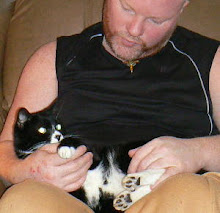

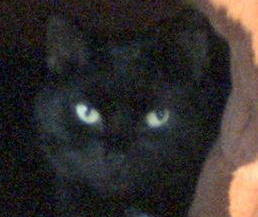.jpg)
